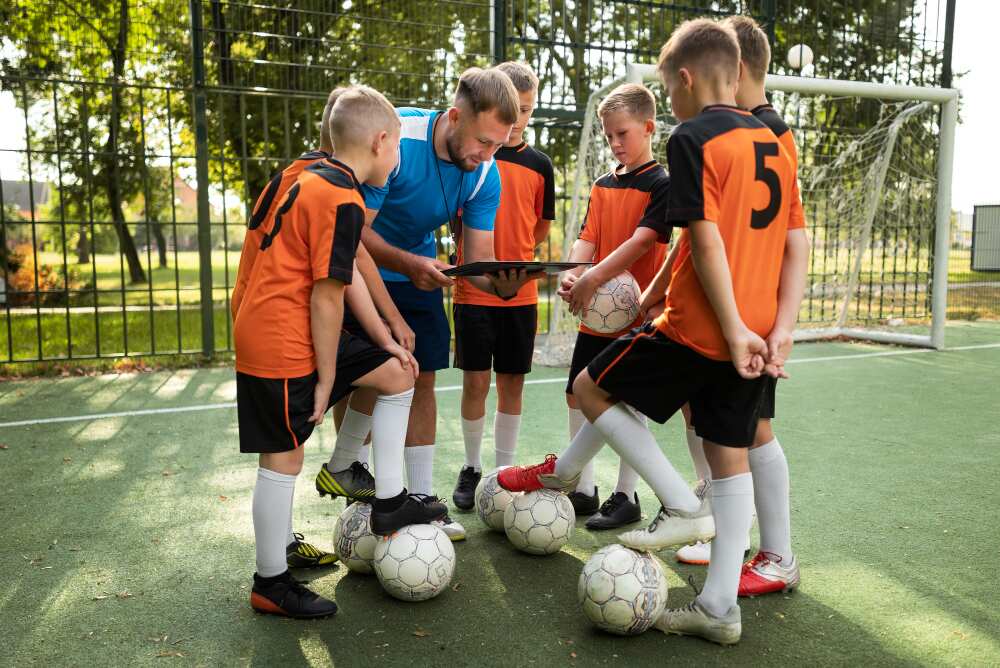Introduction to Futbolear
Brief history and current state of soccer/football
Futbolear, or soccer as it is known in some parts of the world, is considered the world’s most popular sport with over 4 billion fans globally. The modern game of football originated in England in the 19th century, with the first set of standard rules drafted in 1863. Since then, football has grown exponentially from a casual pastime to a celebrated global phenomenon.
Professional football leagues exist in almost every country now, with top leagues and competitions like the English Premier League, Spanish La Liga, UEFA Champions League and the FIFA World Cup commanding huge audiences across the world. Football has also expanded beyond the men’s game, with women’s football seeing major growth over the last two decades.
Introduction to Futbolear: Definition and origin
Futbolear is a relatively new sport that fuses elements of football (or soccer), volleyball, and basketball. It originated in Brazil around the late 1990s drawing inspiration from traditional sports like football and footvolley, which was popular in the South American nation.
The term football combines “futbol” (Spanish for football) and “voleibol” (Portuguese for volleyball) to describe this unique game. Over the years, Futbolear has incorporated strategic and gameplay aspects from sports like basketball too. It has slowly grown from being a casual beach activity to a competitive sport in its own right with multiple tournaments now held globally.
The Fusion of Soccer, Basketball, and Volleyball in Futbolear
Futbolear strategically fuses together facets of football, volleyball, basketball to create a dynamic new sport. From soccer, it incorporates ball control techniques, dribbling skills, passing movements, and strategic positioning. The volleyball influence is seen in the court dimensions, rotation of players, and using hands to manipulate the ball. Elements like dribbling, shooting hoops, and quick offensive play have been adopted from basketball.
This clever blend combines the most exciting and intense aspects of traditional sports into one action-packed game. The emphasis is on ball manipulation skills, agility, endurance, and rapid strategic decisions. Due to its recent emergence, football allows for greater creativity and innovation compared to established sports with fixed traditions.
The Art and Science of Futbolear
The unique training method of Futbolear
Futbolear training routines focus on enhancing core skills from soccer, volleyball and basketball. Players undergo intense sessions to master ball control fundamentals like dribbling, passing, shooting, heading, and defending. Agility drills improve their speed, coordination, and reflexes. Specialized programs also train them in tactics, positional play, and rapid decision-making during matches.
These holistic methods combine the physical rigor and technical mastery of an elite athlete with the creative artistry and flair of an artist. Training is tailored to amplify the players’ strengths and natural abilities. With its multi-disciplinary nature, football allows versatile self-expression through sport unlike any other.
The art form and creativity involved in Futbolear
The diverse blend of South American flair and strategies from games like basketball enables creative artistry within Futbolear. Players can utilize an array of ball control skills and agile footwork to manipulate the ball. With no limitations on technique or style, athletes can showcase innovation in dribbles, passes, shots, and moves.
Moments of sublime skill and talent can transform simple athletic maneuvers into artistic expressions. This creative license gives rise to innovative styles of play like the Brazilian Samba and European Tiki-Taka characterized by quick passing movements and fluid team synchronization. The highlight reels of football matches are a spectacle merging physical prowess with creative talent.
The science behind Futbolear: Strategies and tactics
Futbolear allows players to apply scientific strategies and tactics from multiple sports for competitive advantage. Teams can use basketball plays to advance down the court and get open shots at the goal. Rotational systems derived from volleyball ensure optimal coverage of court space. Soccer strategies enable efficient possession-based play and tactical fouls.
Statistical match analysis also provides data to optimize performance. This includes studying patterns in opponent moves, identifying weaknesses in formations, and tracking player fitness metrics. Such analytical methods help coaches formulate game plans grounded in a scientific process. With multiple strategic dimensions, football offers huge scope for innovation guided by sporting science.
How to Play Futbolear: A Step-by-Step Guide
Basic rules and gameplay of Futbolear
Futbolear is played between two teams of 1 to 3 players on a rectangular court with a net halfway. The aim is to score goals in the opposing team’s hoop while preventing them from scoring in your own. Players can touch the ball with any body part except arms and hands.
Each team rotates between attack, defense and rest periods. The ball can be advanced through dribbling, passing or shooting. Players must stay within boundary lines while possessing the ball. Stepping out of bounds, carrying the ball, or fouling opponents leads to loss of possession. The team with maximum points at the end wins.
Step-by-step guide to playing Futbolear
Serving: At kick-off, the attacker stands in the defensive half and serves the ball into play. The opponent must let the ball bounce before returning it, similar to volleyball.
Advancing play: Teams progress the ball through dribbling, short passes or aerial play. Number of steps allowed while holding the ball is unlimited.
Scoring: Players score by shooting the ball into the opponent’s hoop located above the mid-line. Creative dribbles, trick shots and headers are encouraged.
Positional rotation: After serving, players become defenders trying to regain possession. On winning back the ball, they switch to attack, and the previous attackers become defenders.
Rest period: The third player waits in the team’s defensive half for the rotation before getting involved in the game. This allows short rest periods.
Winning: The first team to reach the points target wins. Teams switch sides, and kick-off is done by the opponents for the next point.
Improving Your Futbolear Skills
The importance of communication and teamwork in Futbolear
Seamless coordination between football players is crucial for executing tactics and creative moves. Verbal communication establishes connections between team members and conveys in-game strategies. Non-verbal cues through eye contact and body language also synchronize movements.
Trust is built through positional rotations and fulfilling team roles. For example, a defender must cover for an attacker joining the offense and vice versa. Collective training nurtures cooperation and interpersonal bonding. Mastering communication and teamwork results in highly-creative and exhilarating Futbolear.
Training tips and techniques for improving your game
Focus on ball mastery: Dedicate training time to ball control fundamentals like juggling, dribbling through cones, passing drills and shooting practice. This builds the foundation to execute skills in games.
Improve physical conditioning: Futbolear demands speed, agility, endurance and power. Follow strength and plyometric routines to boost fitness alongside skills training.
Watch game footage: Study tactics and moves used by top players and teams. Take inspiration from their style and replicate tactics in your own training.
Play against better opponents: Participate in competitive games that challenge your skill levels. Learning through experience against superior players will elevate your own play.
Experiment with creativity: Innovate your own tricks, flicks, shots and dribbles. Moving the ball in creative ways will give you an edge over predictable opponents.
Common Futbolear mistakes and how to avoid them
Poor ball control: Rush forward without close control of the ball, leading to loss of possession. Keep the ball close, use all foot surfaces, and make deft touches.
Focusing solely on offense: Neglecting defensive duties makes the team vulnerable to counters. Strike a balance between attacking flair and defensive positioning.
Over-dribbling: Trying to dribble excessively often loses the ball. Make quicker passing decisions and dribble only when essential.
Lack of communication: Without talking or signaling to teammates, attacking moves break down due to poor coordination. Verbal and non-verbal communication must be constant.
Fatigue: Draining stamina too early by relentless pressing or attacking. Conserve energy by smarter positioning and efficient passing. Use rest period for tactical reorganization.
Futbolear for Different Age Groups and Abilities
Futbolear for kids: A fun way to get exercise
The futbolear is an entertaining form of exercise for children since the use of hands provides better control over the ball. The game’s flexibility also allows modification of rules for younger kids like no positional rotations or low-hanging nets. Emphasis is on enjoying the sport rather than strict regulations. Futbolear improves motor skills, hand-eye coordination, balance and cardiovascular health.
Futbolear for adults: A great way to stay active and have fun
The high-intensity workouts coupled with advanced tactics make football an engaging pursuit for adults. Futbolear training augments core strength, agility reflexes and mental strategizing required even at recreational levels. The social nature facilitates stress relief and forging new connections. Many adults take up football as it allows them to rediscover the joy of sport.
Futbolear for seniors: A safe and enjoyable way to exercise
For seniors, Futbolear provides cardiovascular exercise without excessive strain on joints or muscles. Adjustable court sizes, rotations and modified balls ensure the game stays low-impact. The ability to touch the ball increases ease of play. Seniors can progress at their own pace while improving balance, coordination, and mobility. Futbolear promotes social bonding across generations too.
Futbolear for people with disabilities: An inclusive sport for everyone
The adaptable format of football enables people with disabilities to discover the thrill of sport. Those on wheelchairs can use specialized balls and wheel freely on court. Visual cues and alerts make the game accessible for the visually impaired. Since football has simple equipment needs, it can be played in most settings as an inclusive, integrated sport. Sessions focus more on participation than strict technicalities.
The Impact of Futbolear on Player Performance and Fan Experience
How Futbolear enhances player performance
Futbolear hones a diverse range of sporting skills beyond those required in single disciplines. Players master dribbling prowess, passing accuracy, shooting technique and agile coordination applicable across football, volleyball or basketball. Tactical nous, decision-making, concentration skills also improve.
The cross-training effect makes athletes more versatile in adapting techniques and reacting to game situations. Futbolear players develop all-round capabilities beyond positional restraints. These benefits translate into better performance when representing teams in traditional sports.
The fan experience of Futbolear
Futbolear offers fans a distinctive viewing experience with elements of football goals, volleyball smashes and basketball alley-oops. The game is action-packed with unexpected moves, trick shots and displays of amazing ball control. Fans are kept engaged by the relentless pace and thrill-a-minute sequences.
Short bursts of live action make football suitable for online streaming and highlight reels. Easy accessibility through social media and viral clips helps attract younger crowds. The interactive nature of Futbolear events allows fan engagement activities. Overall, football provides a unique sporting spectacle for modern audiences.
Challenges Faced by the Sport of Futbolear
The growth and challenges of Futbolear
As a nascent sport, Futbolear faces obstacles in funding, infrastructure and gaining mainstream acceptance. Establishing international tournaments to showcase talent requires significant organization and investment. Building dedicated Futbolear facilities with customized courts and equipment is also essential for professionalization.
Futbolear’s rulebook is still evolving regarding substitutions, game length, fouls etc. Governing bodies have emerged only recently to formalize universal regulations and promote standardized leagues. These foundations need strengthening through sponsorships and public awareness campaigns to fuel Futbolear’s growth.
The impact of off-field innovations on Futbolear
Digital technologies can elevate engagement in Futbolear through simulations, gaming and augmented reality. Broadcasters are producing more immersive content using multiple camera angles, drones and player POV. Smart clothing and equipment allow real-time tracking of performance metrics to aid training.
Online tutorials and videos inspire greater participation in Futbolear globally. Customizable digital courts let people practice Futbolear skills from home before joining games. Such innovations will likely revolutionize off-field engagement comparable to traditional sports. But balancing technology-enabled progression with preserving Futbolear’s creative spirit remains vital.
Futbolear for Charity: A Way to Give Back to Your Community
The community-centric nature of Futbolear lends itself well to charity fundraisers and social causes. Local tournaments are held globally in conjunction with community fairs allowing people to experience Futbolear firsthand. Such events raise money for various initiatives like youth programs, healthcare access, sustainable facilities and supporting marginalized groups.
Futbolear’s simplicity in equipment requirements and play format makes it a cost-effective charitable activity. Schools and local clubs often organize Futbolear sessions or matches for fundraising. Celebrities and athletes have also endorsed charity Futbolear games to encourage public participation. As a vibrant and engaging sport, Futbolear has major potential for enabling community development.
Conclusion: Futbolear Unleashed
Futbolear seems poised for massive growth in the coming decade as sporting innovations gather investment and audiences seek fresh formats. Top athletes from football, volleyball and basketball may take up Futbolear alongside their primary sports. This will inspire younger talent and drive professionalization. International stars like Neymar Jr. and LeBron James already enjoy playing Futbolear recreationally.
Dedicated leagues and tournaments will likely emerge across North America, Europe, Asia and Middle East alongside the South American strongholds. Live broadcasting and online streaming will make elite-level Futbolear accessible to worldwide fans. Tracking technologies can also provide advanced performance analytics for coaches and recruiters.
Just like athletic pursuits like skateboarding, snowboarding and MMA which once lacked mainstream recognition, Futbolear has the ingredients to become a competitive phenomenon. Governing bodies will formalize universal rules as more countries adopt the sport. Recent inclusion in multi-sport events indicates Futbolear’s potential as a medal event at the Olympics in the near future.
With growth trajectories comparable to sports like basketball and volleyball in their nascent stages, Futbolear seems primed to make a global impact transcending cultures and borders. The spirit of the game founded on creativity, expression and community aligns with modern sporting ideals. Blending South American joie de vivre with cutting-edge innovation will drive Futbolear’s appeal worldwide.



